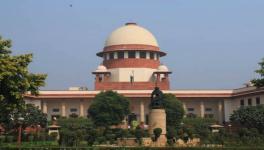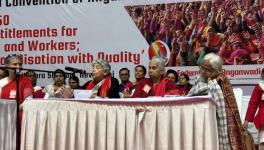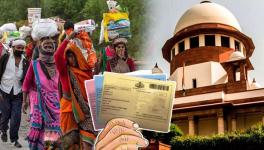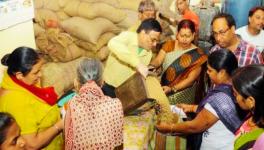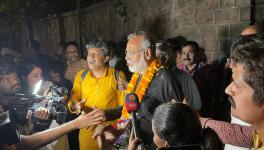'One Nation One Ration Card' Issues Raised by SC & CAG yet to be Addressed
Representational use only.Image Courtesy: The Indian Express
Kolkata: The utilisation of the Union government’s One Nation One Ration Card (ONORC) scheme, of which the migrant workforce is intended to be one of the key beneficiary segments, appears to be gradually picking up; However, certain issues raised in a Supreme Court order and report of the Comptroller and Auditor General of India (CAG) remain to be addressed.
The missing link in the chain of states and Union Territories (UTs) for the gradually stabilising ONORC scheme under the National Food Security Act of 2013 was Assam for a fairly long time, despite the Supreme Court setting July 31, 2021, as the last date for rolling out the facility. Ultimately, overcoming the impasse resulting from National Population Register-related issues, Assam could join the ONORC arrangement on June 21, 2022. With that, all 36 states/UTs became participants in the scheme.
Even in an economically-backward state Jharkhand, which traditionally has a record of outbound and inbound migration, ONORC transactions are on the rise, gradually from a modest start. Statistics made available to NewsClick by the state’s department of food, civil supplies, and public distribution show that persons from outside the state who lifted rations in Jharkhand, as expressed in terms of ration card count, improved from 165 in April 2021 to 640 in December and peaked to 791 in January. For February and March, the count was 669 and 559, respectively.
In the same period and on the same basis, persons from Jharkhand who lifted ration in other states stood at a low of 112 in May, going up substantially to 1,896 in December, 2,312 in January, 2,361 in February, and 2,911 in March.
In the first quarter of the current financial year, under the first category of persons from outside lifting ration in Jharkhand, the count stood at 1,320.
Under the second category, the figures for the April-June quarter add up to 7,715, not very different from 7,854 for the January-March quarter of 2021-22.
Variations among states, where outbound migration is conspicuous and inbound migration are not pronounced, stem from various economic reasons. However, migrants are at last able to get dry rations with ONORC in a large number of places, sources told NewsClick.
The position regarding allocation and distribution of foodgrains in Jharkhand in three years from 2019-20 to 2021-22, figures suggest, has been stable, with distribution working out to 94.89%, 94.77% and 95.5%, respectively.
According to Union food ministry statistics appended to the report for 2021-22, while 100% digitisation of ration cards has been achieved throughout the country, the position regarding Aadhaar seeding with ration cards as of the end of February shows West Bengal among the laggards at 63%, worse than Bihar’s 83%. It was a non-starter in Meghalaya, 31% in Manipur and 59% in president-ruled UTs of what earlier was the state of Jammu & Kashmir. The overall average is at 84%. Chhattisgarh and Jharkhand achieved 100% and 97%, respectively.
ONOR had a very modest beginning in August 2019; its implementation slowly picked up from mid-2020 and gathered pace by early 2021, and Assam’s joining it on June 21 technically completed the exercise.
From August 2019 till June 2021, 71 crore portable transactions – 43.6 crore under NFSA and 27 crore under Pradhan Mantri Garib Kalyan Anna Yojana - took place. Currently, a monthly average of about three crore portable transactions is being recorded, which government sources claim is a “key indicator” that ONORC is functional.
But, certain directives of the Supreme Court are yet to be carried out, and certain comments of CAG remain to be addressed.
A division bench of Justices Ashok Bhushan and MR Shah, while disposing a suo moto writ petition on June 29, 2021, had directed the Union government to undertake an exercise under Section 9 of NFSA to “re-determine the total number of persons to be covered under the rural and urban areas.”
This was in the context of the states’ demand for dry rations for distribution among migrants.
The division bench also directed all states and UTs to register all establishments and license all contractors under the Act of 1979 to ensure that the statutory duty imposed on the contractors to give particulars of migrant workers is fully complied with.
The Supreme Court then came down heavily on the Union labour ministry for the abnormal delay on its part in launching the national database for unorganised workers. While the directives are yet to be acted upon, the e-shram portal launched on August 26, 2021, with a toll-free number 14434, does not offer access for registration to workers without Aadhaar.
Additionally, workers registered with different boards cannot be included. Further, it is individual worker-based with no provision for family members/dependents. These and other issues have to be sorted out by the ministry in consultation with workers’ organisations, trade union sources told NewsClick.
CAG, in its performance audit report (no. 24 0f 2021) on the function of the Unique Identification Authority of India, flagged flaws in the de-duplication process and issue of Aadhaars on faulty biometric data and documents.
Though UIDAI has acted to improve the quality of biometric data and introduced iris-based authentification features for enrolment, the database continued to have faulty Aadhaars already issued. Also, instances are galore of issues of Aadhaar with the same biometric data to different residents, indicating flaws in the deduplication process.
It is possible that the seeding of Aadhaar with a ration card fails because of a mismatch in the individual’s personal information. People who access or want to access the PDS (Public Distribution System) ration cannot identify the mismatch/mistake, and the same remains uncorrected for a long time.
Issue of Aadhaar to minor children below five based on biometric data of their parents, without confirming the uniqueness of their biometric identity, goes against the basic tenet of the Act. UIDAI needs to review the matter and find alternate ways to establish their unique identity, especially since the Supreme Court has stated that no benefit can be denied to any child for want of Aadhhar, CAG had observed.
In this context, mention may be made of the observation made in a recent report titled "Datafication of the Public Distribution System in India" – a case study of Chhattisgarh and Jharkhand.
The study, brought out by Bengaluru-based The Centre for Internet & Society and authored by Sameet Panda with research support from Sonalimayee Sahu, notes: “Under NFSA, there is no age limit for beneficiaries, which means that all members of the ration card holding household, including children, are entitled to foodgrain right from birth. However, Aadhaar enrolment among children below five years is just 32% nationally and 42% and 26%e in Chhattisgarh and Jharkhand, respectively. Since no person is entitled to receive rations without submitting their Aadhaar details, 66% of children under five are automatically excluded from PDS. The exclusion of children means loss of entitlement for the family.”
This is despite specific official instruction not to deny entitlement for not having Aadhaar.
The Jharkhand food department’s response to NewsClick, however, notes: “Children are getting ration as family members even if they don’t have Aadhhar no., as lifting is done by (an) elder member having Aadhaar card."
The other observations of the report are: “In all the challenges a beneficiary faces, the state appears absent. It does not play an active role in making the datafication process people-centric. Rather, the state seems happy to remove eligible beneficiaries if they do not provide the necessary documentation”.
PDS serves the poor – the bottom 80% – but their right to privacy is as fundamental as that of the top 20%.
Get the latest reports & analysis with people's perspective on Protests, movements & deep analytical videos, discussions of the current affairs in your Telegram app. Subscribe to NewsClick's Telegram channel & get Real-Time updates on stories, as they get published on our website.









